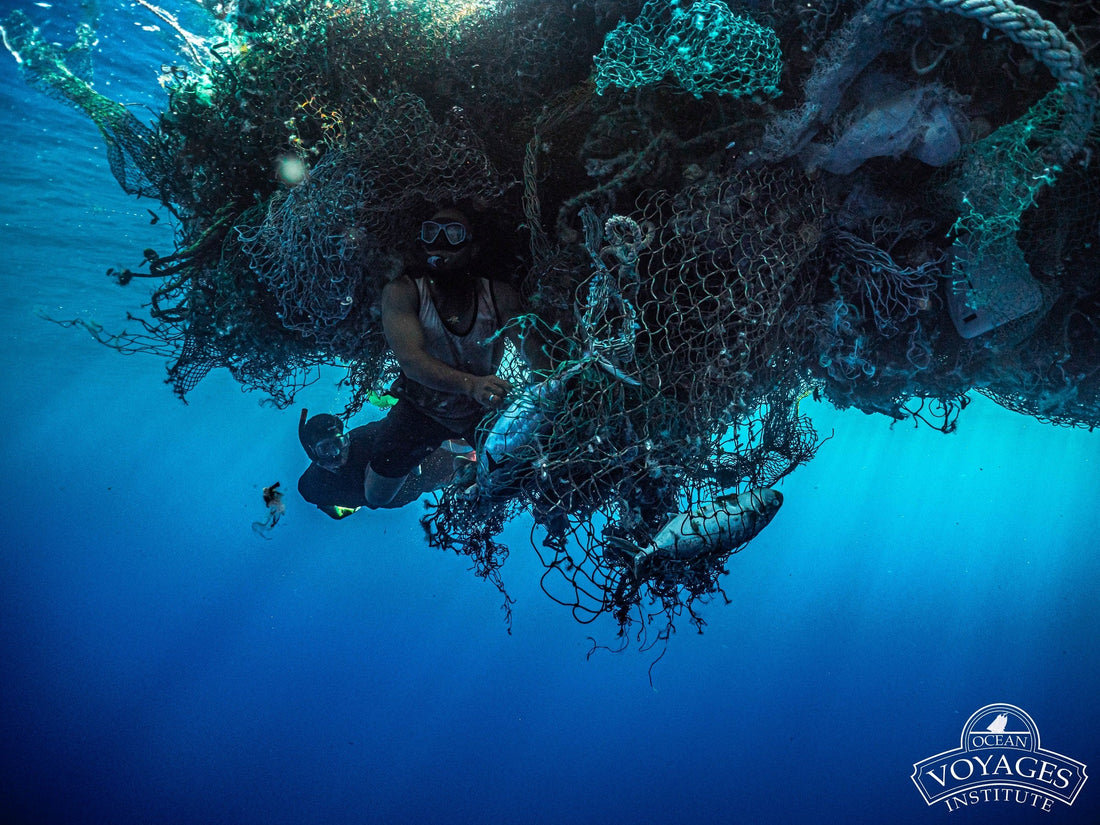
The largest garbage vortex: The Great Pacific Garbage Patch
Share
What do you get if you mentally triple the size of France? A vast area: the estimated size of the Great Pacific Garbage Patch. This is a massive patch of plastic garbage in the North Pacific, largely made up of ghost nets. How does all this plastic get there, what are these nets all about, and what can you do to protect the oceans from plastic? Read on!
What exactly is the Great Pacific Garbage Patch?
The Great Pacific Garbage Patch is located in the North Pacific and consists of two zones where garbage accumulates. The reason why the garbage accumulates in these particular places is due to ocean currents. The North Pacific Gyre stretches clockwise across the entire North Pacific. Any garbage has a hard time escaping this gyre because the Oyashio Current in the north and the Equatorial Current in the south repeatedly spew the garbage back into the North Pacific Gyre. The Great Pacific Garbage Patch continues to grow. It is the largest and most well-known garbage patch in the world, alongside four others in the South Pacific, the North and South Atlantic, and the Indian Ocean.

(Global environmental problems infographics.)
How big is the Great Pacific Garbage Patch?
But how big is the problem of the Great Pacific Garbage Patch? We've just heard: According to estimates, the Great Pacific Garbage Patch is three times the size of France, or alternatively, one could say four and a half times the size of Germany. The study that examined this dates back to 2018 – so today the Great Pacific Garbage Patch is even larger.
The amount of plastic waste in the Great Pacific Garbage Patch is enormous. 1.8 trillion pieces of plastic in the Great Pacific Garbage Patch, which means an average of 230 pieces for every single person on Earth. Many of these pieces are tiny and are considered microplastics. Marine fauna often mistake the plastic pieces for food and ingest them. The result: Because fish, birds, and other animals cannot digest the plastic, they die.
The problem of ghost nets
The problem of Ghost nets is, of course, particularly relevant to us at BRACENET. These are old fishing nets that have either been lost at sea or intentionally dumped in the ocean. They are among the most dangerous types of plastic waste, as they continue to fish and kill countless marine animals. And now comes a stark number: 46% of the plastic waste in the Great Pacific Garbage Patch consists of ghost nets . Yes, old fishing nets make up almost half. It's high time to recover them and put an end to the ghost net plague!
By the way: Recovering and disposing of ghost nets is our daily business. Take a look at our Upcycling products Come on over and help us save the oceans!

We upcycle recovered ghost nets into new products such as bracelets, key rings and dog leashes
How the Ocean Voyages Institute is tackling the Great Pacific Garbage Patch
Here comes the Ocean Voyages Institute This comes into play. The organization travels to the North Pacific every year to clean up the Great Pacific Garbage Patch. In 2020 alone, the Ocean Voyages Institute fished 170 tons of garbage, mostly ghost nets, out of the plastic vortex – and the team has already recovered almost 350 tons in total (as of April 2023). To recover the garbage, the Ocean Voyages Institute attaches GPS transmitters to ghost nets – assuming that the ghost nets would carry them along with ocean currents to more garbage. This assumption has proven correct, allowing larger quantities to be recovered more effectively.
Partnerships against the plastic flood
We've partnered closely with many organizations to help save the oceans from plastic waste. Among other things, we made two bracenets from the nets recovered by the Ocean Voyages Institute, donating over €3,500 to their mission.
Would you also like to help rid the oceans of ghost nets? Then take a look at our Bracenets We handcraft all of these bracelets from recovered ghost nets or discarded fishing nets. We regularly donate the proceeds to Healthy Seas to fund recovery missions and preventative measures, and we support many other projects to protect the oceans and marine animals. To date, we have donated a total of over €272,000.
How about our bestsellers Baltic Sea , Black Sea , or North Sea ? Or if you prefer something more simple, we'll donate €2 to Sea Shepherd Germany for your Sea Shepherd Bracenet made from our Black Sea fishing net.

A bracenet made from fishing nets from the Great Pacific Garbage Patch
What you can do to combat marine pollution
- Avoid using plastic in your everyday life as much as possible . Germany exports a large portion of its recyclable waste to Asia , which then potentially ends up in the Great Pacific Garbage Patch.
- Avoid industrially caught fish . Large fisheries contribute to species extinction at and threaten our seas with their giant ships.
- Speak up: There are always petitions against single-use plastics in wholesale stores. Do your part to protect our oceans.
- Make a visible statement with our Bracenets and help us save the oceans. Because ghost nets and microplastics are a threat to everyone, not just animals!
